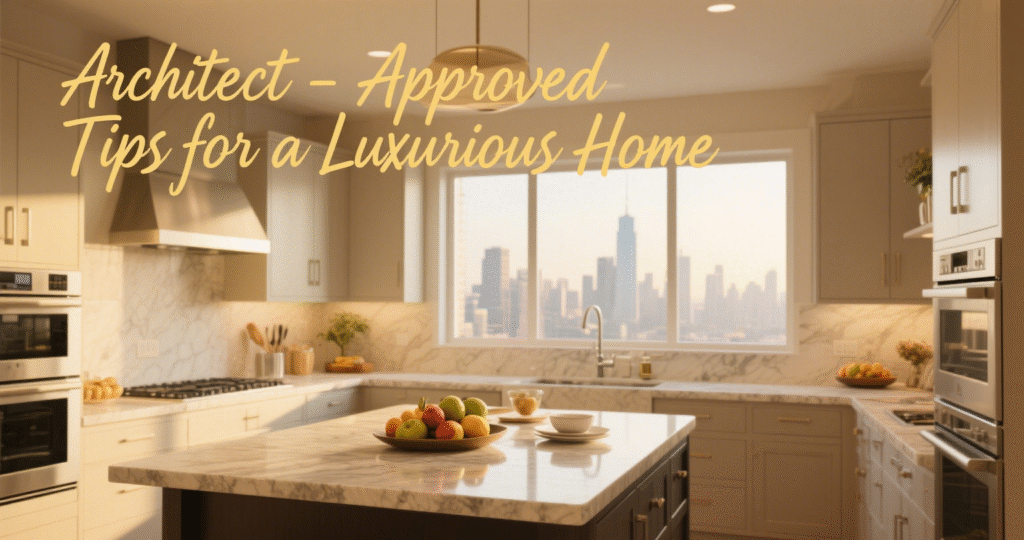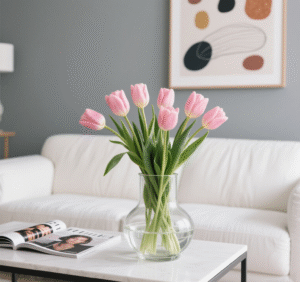This post may contain affiliate links which means we may receive a commission at no cost to you, if you make a purchase through a link. Please see our full disclosure for further information.
Want your home to look more luxurious and expensive? It doesn’t take a fortune. You can make your home look high-end with smart design choices. Here are twelve design tips to elevate your space.
Curves Add Elegance
Curves and organic shapes can make a room feel more luxurious. Studies show that curved objects activate the parts of our brains linked to safety and comfort. We find them more pleasing, and we value what we like.
Curves are also harder to make. Effort equals value. Flat-pack furniture often has obvious joints and looks easy to make. Smooth, continuous designs show craftsmanship. These details make something seem rare and luxurious.
- If you have space for curves, add them.
- A round dining table in a slightly round room can look great.
- Even small touches, like an oval rug or ball-shaped cushion, can help.

Use Materials That Age Well
For a timeless, luxurious home, use materials that age beautifully. Think of materials like:
- Natural stone
- Metal that changes over time
- Wood
- Leather
- Plaster or lime wash walls
These materials have been around for centuries. They looked good in the past, look good now, and will look good in the future.
Cheap materials like laminate, plastic, and vinyl don’t age well. They scuff, crack, and need to be replaced. High-quality materials develop character over time. They feel heavy, which also feels expensive.
Integrated Storage Reduces Clutter
Built-in storage reduces clutter. Clean, uninterrupted spaces make your brain think the area is bigger. Everything looks cleaner and more sophisticated.
Built-ins also show custom work. This seems rare and takes a lot of effort. We value this as human beings. It seems expensive, even if you do it yourself.
If you add built-ins:
- Run them along the entire wall.
- Take them up to the ceiling.
- Use high-quality hardware and finishes.
- Avoid plastic handles and fake wood knobs.
- Go for metal finishes, marble knobs, and brassy hardware.
Sculptural Furniture as Art
Choose furniture that can also be a sculpture. Not every piece needs to be art. You have to live in your home, so it needs to be useful. But, you can pick a few pieces that are beautiful and functional.
Think of a curvy chair, a geometric coffee table, or a lamp with flowing shapes. These designs draw attention. They break away from the ordinary. This makes you wonder about them, and they can add visual interest.
Photos are Not Always Art
Art ties a room together with balance, harmony, and mystery. Photos can be meaningful, but too many can be too personal. Keep some photos in your bedroom or study. In the dining room and living room, less is more.
Abstract art or less private photos make a space feel more open. It is more universal.
Contrast Sizes of Decor
Imagine a room where every piece of art is the same size. It looks neat, but also boring. Now picture a room with:
- Towering canvases
- Small paintings leaning on a shelf
- Sketches on the wall
The room feels more dynamic and expensive.
Different sizes grab our attention. It makes you think the collection was built over time, not bought all at once. We value spaces when we feel someone put thought and effort into them.
Start with big statement pieces, then add smaller pieces. Play with arrangements that are not perfectly even.
Frame Artwork
If you want to add art to your home, frame it. But, do not get matching frames for everything. Mismatched frames make your display feel like a collection built over time. This is what designers do. They shop for frames that fit the art.
Mix, Don’t Match
Have you noticed that furniture rarely matches in design magazines or hotels? Matching furniture sets can be boring.
Pair modern furniture with vintage pieces. If everything is new and matching, it looks soulless. If everything is old, it can feel stuffy. Mix and match to find a balance that you like. The key is not to fill a room with the same stuff from one product line.
Go Big
Make the decor in your home larger than your head. Anything smaller can look cluttered. Big pieces look planned. Small pieces feel like filler. Think about hotels and designer homes. You do not see shelves packed with tiny trinkets. Instead, they have bold vases, sculptures, and lamps.
If you have small decor items that you love, group them together. Put them on a tray. This makes them look like one large item instead of many small ones. This can reduce clutter.

Less is More
Leave your open shelves half empty. It is better to be under-decorated than over-decorated. Empty space is a sign of luxury. Think about luxury stores or the Apple Store. They show very few items with a lot of space. This is different from a flea market, where everything is on display.
If you want your space to feel more expensive, less is more. If you put a piece of furniture in a museum with lots of space, it becomes art.
Hide the Ugly
Nothing functional and ugly should be on display. Messy items bring too much reality into the space. Luxury is clean and hard to maintain. You do not see toothpaste tubes and mismatched bottles. Instead, you see dispensers, glass jars, and marble trays.
If you want your home to look expensive, hide away ugly, practical things. Put soaps, shampoos, and cleaning products into glass or neutral containers. Stash wires, toiletries, and snacks into cabinets or baskets.
Accent Walls: To Do or Not To Do
Accent walls can be fun, but they do not always feel luxurious. They can feel more DIY.
Expensive interiors use textures, colors, and materials across the whole space to create balance. If you want your space to feel well thought out, commit to the whole room. If you want to paint your walls a color, do the whole space, maybe even the ceiling. If you want to put up moldings, do it across the entire surface in that one room.
Final Thoughts
You do not need to spend a lot of money to make your home look luxurious. By using these design tips, you can create a space that feels elegant and expensive. Experiment with these ideas and see what works best for you.
Ready to transform your home? Start with one or two of these tips and see the difference they make!
5 Star Hotel Interior Design Ideas & More!
How to Make Your Home Feel Like a Five-Star Hotel – Italic
8 Steps to Turn Your Bedroom Into a 5-Star Hotel Room
Uncover further inspiration in our blog.












